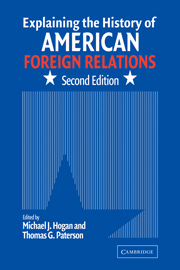Book contents
- Frontmatter
- Contents
- Preface to the Second Edition
- Contributors
- 1 Introduction
- 2 Defining and Doing the History of United States Foreign Relations : A Primer
- 3 Toward a Pluralist Vision : The Study of American Foreign Relations as International History and National History
- 4 Theories of International Relations
- 5 Bureaucratic Politics
- 6 Psychology
- 7 National Security
- 8 Corporatism
- 9 World Systems
- 10 Dependency
- 11 Considering Borders
- 12 The Global Frontier : Comparative History and the Frontier-Borderlands Approach
- 13 Modernization Theory
- 14 Ideology
- 15 Culture and International History
- 16 Cultural Transfer
- 17 Reading for Meaning : Theory, Language, and Metaphor
- 18 What's Gender Got to Do with It? Gender History as Foreign Relations History
- 19 Race to Insight: The United States and the World, White Supremacy and Foreign Affairs
- 20 Memory and Understanding U.S. Foreign Relations
- Index
2 - Defining and Doing the History of United States Foreign Relations : A Primer
Published online by Cambridge University Press: 05 June 2012
- Frontmatter
- Contents
- Preface to the Second Edition
- Contributors
- 1 Introduction
- 2 Defining and Doing the History of United States Foreign Relations : A Primer
- 3 Toward a Pluralist Vision : The Study of American Foreign Relations as International History and National History
- 4 Theories of International Relations
- 5 Bureaucratic Politics
- 6 Psychology
- 7 National Security
- 8 Corporatism
- 9 World Systems
- 10 Dependency
- 11 Considering Borders
- 12 The Global Frontier : Comparative History and the Frontier-Borderlands Approach
- 13 Modernization Theory
- 14 Ideology
- 15 Culture and International History
- 16 Cultural Transfer
- 17 Reading for Meaning : Theory, Language, and Metaphor
- 18 What's Gender Got to Do with It? Gender History as Foreign Relations History
- 19 Race to Insight: The United States and the World, White Supremacy and Foreign Affairs
- 20 Memory and Understanding U.S. Foreign Relations
- Index
Summary
This “primer” seeks to define the field of the history of United States foreign relations (what are we trying to do?), identify some of the well-explored topics in the field (what are we doing successfully?), and suggest some fresh approaches. How have changes in technology and environmental problems shaped U.S. foreign policy? How have the transfer of culture and the cross-border activities of individuals, corporations, and other non-state organizations changed the concerns of governments and the meaning of foreign relations? How can methodologies adapted from literary criticism, anthropology, and other fields of history open possibilities for foreign relations history?
All foreign relations historians are engaged in explaining over time the interaction of states, peoples, and cultures in the international system. We study U.S. expansion into Mexico in the nineteenth century; twentieth-century anticommunism; and economic influences, such as lending by the U.S.-dominated International Monetary Fund and operations overseas by U.S.-based corporations. We analyze the intersection of cultural and economic forces, such as in Nike's promotion of basketball star Michael Jordan as a symbol for high-fashion sneakers that are made in low-paid nations and consumed in the United States and in other rich nations. We also study U.S. individuals abroad, such as tourists and the wives of diplomats. “But are tourists or spouses of diplomats really involved in the making or executing of foreign policy or in the process of diplomacy?” critics might ask.
- Type
- Chapter
- Information
- Explaining the History of American Foreign Relations , pp. 10 - 34Publisher: Cambridge University PressPrint publication year: 2004
- 2
- Cited by



